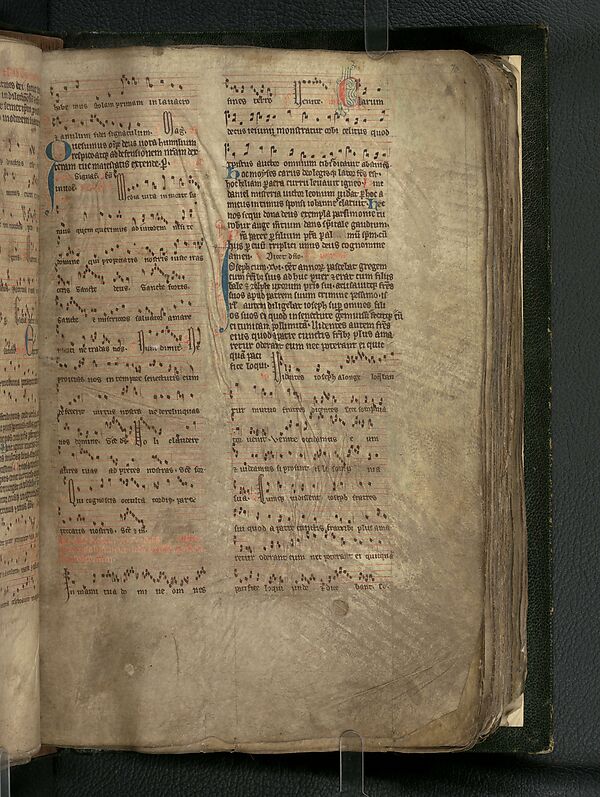Breviaries.
Subject
Subject Source: Local sources
Scope Note: Refers to books or other documents that contain the psalms, hymns, prayers, lessons, and other recitations necessary to enable a Catholic or other Christian cleric to recite the daily Divine Office at designated hours of the day. The breviary as a condensed work in one volume appeared in the 11th century, although the texts of the longer Divine Office were established in the Roman rite by the 7th century and in Carolingian Europe by the 10th century. Breviaries may contain elaborate illumination.
Found in 9 Collections and/or Records:
Fourteen narrow strips of vellum from a breviary., 14th century.
File
Identifier: Adv.MS.84.1.20
Scope and Contents
Only three pairs of fragments are contiguous and at least four bifolia have been cut up to provide these strips; (one fragment which is blank on both sides cannot be located). The breviary appears to have been of a rather plain nature, there being no illumination and no stave visible in the fragments. The text is written in double columns, and some initials and rubrics in red may be discerned.
Dates:
14th century.
Fowlis Easter breviary.
Item
Identifier: MS.21247
Scope and Contents
A manuscript written in Scotland, which belonged to the Mortimer family of Fowlis Easter in Angus.The contents are as follows:
(i) Temporale. (Folio 1). It includes (folio 127) the Great rubric, lectiones, the office 'In dedicatione ecclesie' and prayers to St Christopher and the Virgin.
(ii) Calendar in red and black. (Folio 158). Entries in red include Saint Vigean (20 January), Margaret of Scotland (19 June and 16 November), Moloc (25 June), Blaan (10 August) and Marnoc (25...
Dates:
Mid fifteenth century.

Late 13th-century manuscript known as the 'Sprouston Breviary'.
Item
Identifier: Adv.MS.18.2.13B
Scope and Contents
This manuscript was produced in Scotland in the late 13th century, probably sometime between 1285 and 1300 according to Hair and Knott. Borland, Frere and McRoberts have suggested that it may be of the early 14th century, but most scholars agree that it was written sometime around 1300. The manuscript contains musical services as well as the text of Church services according to the Use of Sarum. The work is written in littera textualis in double columns of unequal length....
Dates:
Late 13th century.
Manuscript known as the 'Herdmanstoun Antiphonal', or 'Herdmanstoun Breviary'.
Item
Identifier: Adv.MS.18.2.13A
Scope and Contents
Manuscript known traditionally as the Herdmanstoun Breviary, but more correctly described as an Antiphonal. It was written in the north of England, possibly Northumberland, but later taken to Scotland and altered. It has been suggested by Höhler that the manuscript was possibly written for the college of canons founded at Chester-le-Street by Bishop Anthony Bek of Durham. Bannister speculates that the volume may have been brought to Scotland during the reign of David II (1329-1371). ...
Dates:
Circa 1300
Microfilm of late 13th century manuscript, known as the 'Sprouston Breviary
Item
Identifier: Mf.Sec.MSS.884
Dates:
Late 13th century.
Microfilm of manuscript known as the 'Herdmanstoun Breviary'.
Item
Identifier: Mf.Sec.MSS.466
Scope and Contents
Adv.MS.18.2.13A.
Dates:
[Circa 1300.]
Miscellaneous documents concerning Montrose and Angus, the Covenanters and other matters.
File
Identifier: MS.5407
Scope and Contents
The contents are as follows.(i) Miscellaneous documents, 1539-1838, relating to the burgh of Montrose and the surrounding country. They include papers relating to the Priory (folios 5-6, 11) and the town council (passim), the death-roll of the Plague, 1648 (folio 18), and fragments of the treasurers' accounts, 1676-1704 (folios 37-53); from folio 54 onwards are a number of legal papers, some fragmentary, mainly concerning lands in Angus.(ii) Miscellaneous documents,...
Dates:
1539-1838.

The Sweetheart Breviary, a breviary written in the 14th century for use at Sweetheart Abbey, near Dumfries.
Item
Identifier: MS.40000
Scope and Contents
The winter part of a Breviary written for use at the Cistercian Abbey of Sweetheart near Dumfries, which was founded in 1273 by Dervorguilla (Dearbhfhorgaill) of Galloway, widow of John Balliol. The Breviary, which follows Scottish Cistercian practice, can from internal evidence be dated to 1330-1350. The calendar includes the feast of St Thomas Aquinas, which was added to the Cistercian calendar in 1329, but omits feasts that were added in 1350 or later. In addition to...
Dates:
Ca. 1330-1350.
Two discontiguous parchment fragments apparently from the same leaf of a noted Breviary., 15th century.
File
Identifier: Adv.MS.84.1.5
Scope and Contents
The fragments contain the end of the office of Matins and the beginning of Lauds and are connected with Saint Stephen, although apparently not from the offices for his feasts. The name of Saint Lucian is also mentioned.
Dates:
15th century.
